Alexandra, Hilary, Rebecca, Lauren, Abel, Cain & Joseph
Saturday, April 25, 2009
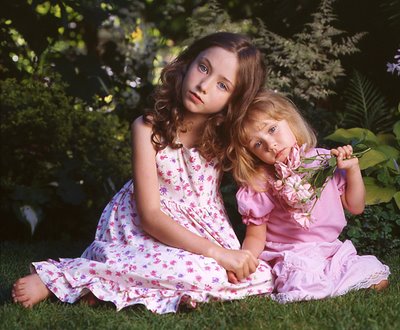 When I started this blog in January 2006 I had no idea what blogging was all about. It took a while for me to figure out how to move pictures around so that copy would wrap around them as in a magazine. But it was the content that took a while. Early on I decided to write about Rebecca, my oldest granddaughter (she was 8) and my relationship with her. At the time her younger sister, Lauren was 3. Lauren was a difficult child who did not like to eat anything and as things looked it seemed she would demand to be breast fed until her teens. Lauren not only resembled and resembles my daughter Hilary but in many ways she is much like her in personality. When Hilary was 3 and her older sister Alexandra was 6 we drove in our VW Beetle to San Francisco. While there Hilary refused to walk with me or hold my hand and demanded to be held and carried by Rosemary. It made me furious and jealous. Because we had been teaching English in Westin Hotels in Mexico City we were given courtesy free stays in the best Westin Hotels. In San Francisco we stayed at the legendary St. Francis. One early morning we sat down for breakfast in the elegant dining room and Hilary began to cry. Soon she was screaming. A tuxedo-wearing waiter came to us and asked, “Madam, is there anything I can do for the young lady?" Rosemary answered, “I’m afraid not, unless you can bring her beans and tortillas.” The trip, thanks to Hilary, was a nightmare. We expected that her elder sister keep her company and take care of her. It seems now that Ale from an early age had the burden of being her sister’s watcher. Through those years Ale grew up and was independent. She made friends easily and did well in school without really trying. In our Arboledas neighbourhood, which was on the outskirts of Mexico City, I was known as the man whose daughter would lie down on the sidewalk to sleep siesta. This is something that Hilary perfected by age 3. She also had the curious habit of looking at you by turning her head sideways so that both eyes coincided as if she were looking at you with only one of them. This sideways glance in Mexican Spanish is “mirar de re-ojo” and it generally unsettles most people. Some think it might be associated with “mal-ojo” or bad eye, a witch’s glance. When we arrived to Vancouver in 1975 we both had to work so it was Ale’s job to take care of Hilary. I remember the first day I took Hilary to daycare. She cried and cried and I felt so sorry I almost brought her back home. For some years my cruel suggestion that if she did not behave I would take her to the daycare was an efficient method to keep Hilary in check. I regret that now. School for Ale was simple and a social endeavour. She went to meet her friends and got decent grades even though she did not study much. With Hilary it was different. In school she was shunned for being different and only now have I found out that she was beaten up with frequency. She made few friends and for many years, our Vancouver evenings were spent with Rosemary working with Hilary on her homework. Our proudest moment happened when we went to Hilary’s graduation at Simon Fraser University. Her Bruce Stewart had Rebecca (1) in his arms as she lined up to get her diploma. It is difficult for me to answer the question as to which of my two daughters is my favourite. Perhaps when they were both young, Ale, as my firstborn had that extra quality that made me favour her. But as years have passed by I have come to understand that by deciding that Ale in her startling independence did not need too much of my attention and concern, I did not give her the affection she craved.  Now one is 40 and the other is 37. I seen in Ale more than a daughter but a real friend. We talk on the phone we, e-mail, we visit in Lillooet and it is very pleasant. With Hilary I feel that I am in the presence of my mother. She looks a lot like my mother and has my mother’s sweetness. I watch her take care of her daughters with a love an attention that rivals my mother's. Which is my favourite? About the only way I can safely answer that is in the way I answer to, “What’s your favourite rose in your garden? “ “It depends on the day, the week and the month!” As Rebecca, 11, signals her own independence and approaches her teenage years I have now noticed Lauren, who at age 6, is sweet and loving. She no longer screams or cries at the table. She eats almost anything even though she must smell it if it is something she has not eaten before. She wants to be photographed while Rebecca does everything possible to avoid it. When I cook, Rebecca is at the computer or watches TV. Lauren brings the step stool and so she can watch me cook. She tries to help. Rebecca refuses to wear dresses. Lauren wants to wear dresses. Which one is my favourite? Is this a fair question? This question became an issue with the first born human. And it seemed to make it all worse that it was God who in the story was the one who had made Abel His favourite. Jacob showered his son Joseph with more love and attention. His jealous sons sold him to slavery in Egypt. It would seem then that it is difficult to show impartiality with one's children. As on only child I never had that problem at home.   Lauren is endearing herself to me much in the same way as her sister did in years past. Children go through similar phases. Lauren is going through the “I like my grandfather” phase now. But I can also discern a peculiar difference. This peculiar difference is exciting and now I long to see not only Rebecca tramp into the house but also my dear and sweet Lauren. This is because it has taken me all this time to notice beyond how different they both are and how comparison is a silly method for showering one’s affection. It just happens.
Susan Hogan, Bill Richardson, Bunny Watson & A Remington Portable Model 5
Friday, April 24, 2009
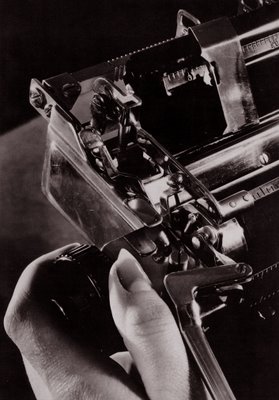
Thursday night's performance in Granville Island, of the Art Club's Age of Arousal (a play written by Linda Griffiths and directed by Katrina Dunn) initiated an activity in my head similar to that primitive computer game Pong. Ideas and associations were bouncing off and I almost became giddy with my excitement. I had an intense Bunny Watson moment. What's that? Read below.
Bunny Watson was a Canadian radio program, which aired Saturday evenings on CBC Radio One and Sunday evenings on CBC Radio Two.
Named for Katharine Hepburn's librarian character in the movie Desk Set, the show was hosted by Bill Richardson, below, right, and was produced by Jennifer Van Evra and Tod Elvidge in Vancouver. Inspired by the Hepburn character's quote that she "associates many things with many things", Richardson explored a particular theme each week through his personal associations with music, literature and film.
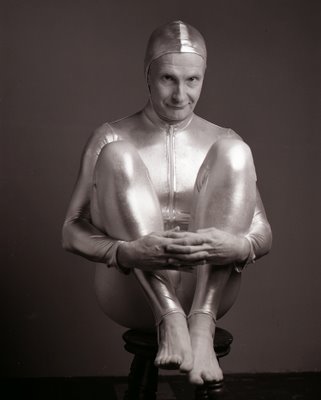 |
| Bill Richardson |
The show first aired in the fall of 2004. In one of the show's most notable episodes, on October 2, 2004, the poet and performance artist Meryn Cadell came out as transgender.
The program ceased to air on the full CBC network in 2006, although repeats continued to air in Nunavut until the summer of 2007 to fill a scheduling hole created by time zone differences, and on Radio One's Sirius Satellite Radio channel to fill a scheduling hole created by the satellite channel not broadcasting local programs.
---------------------------------------------------------------
The above is from Wikipedia. I can only add that Bunny Watson was my favourite CBC Radio program. We had the opportunity to enjoy a dazzling and cerebral program but the ratings must have been low so the program was axed and now we have lots of Pablum. And if you must enjoy the dazzling and cerebral (and funny) Bill Richardson then "your thing" better be the opera.
In January 2006 I started this blog. Its framework is inspired by Richardson's Bunny Watson. I like to somehow bring together things that outwardly may seem disparate. I firmly believe that our ability to associate is what really makes us human.
If I digress in too many directions, and bore you, don't quit quite yet. Rosemary and I were sitting very close to theatre critic Jerry Wasserman. I watched him during the performance. Like us he did a lot of laughing. I am sure he has written a glowing review here. Now you can quit as I will now digress.
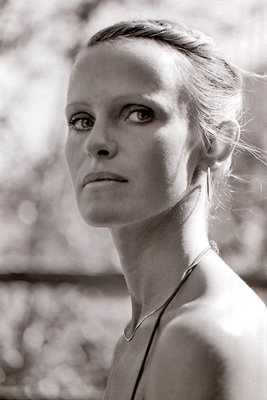
Right off the bat the stage was designed to look like the front end of a vintage Remington typewriter. The curves of a Remington are nearly as sensual as that of a woman. When each act and scene was typed on a projected screen and I heard Chris Hind's (Sound Design/Composer) rendering of a typewriter in action, it was sensual music to my ears. I remembered my grandmother (she was a terrific typist and a stenographer) typing on her Remington Portable Model 5. I now own that precious jewel of a machine.
When Susan Hogan, above, centre (she plays veteran suffragette Mary Barfoot) appeared on stage she threw me back to the last time I had seen her in person. I had photographed her in Egmont, B.C. the summer of 1979.
Laara Sadiq walked on stage. She is the self-styled "definitely odd" Rhoda Nunn who works for Mary Barfoot who runs a typing school for girls of possible ill-repute or down and out. She is precise, quite cold (she makes a wonderful reversal towards the end of the play that had this 66 year old feeling things he should not be feeling if heart attacks are to be avoided.) in her demeanor to Hogan's warmer approach. I was suddenly thrown into thinking of that beautiful William Wyler film The Children's Hour (1961) with Audrey Hepburn and Shirley MacLaine. The two women run a private school for girls and are accused by one of their nasty students of being "definitively odd".
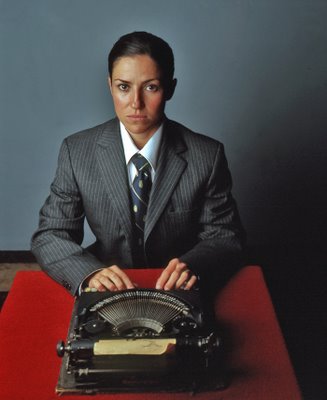
As soon as Kerry Davidson as Virginia Madden, Gwynyth Walsh as Alice Madden and Jennifer Mawhinney as Monica Madden walked on stage I was transported to one of my favourite films of all time, George Kukor's 1939 The Women. The cast was stellar as you had Norma Shearer being almost friendly with Joan Crawford plus there was Rosalind Russell, Joan Fontaine and the luminous Paulette Goddard, plus of course Hedda Hopper! The performance of these Madden sisters was no less stellar.
When Jennifer Mawhinney's (she looks terrific in a suit, tie and moustache) alcoholic antics hit the stage I had another Bunny Watson moment. She is not at all like Marjorie Main (wonderfully gruff in The Women) but somehow here was a character that had the same matter of factness that Marjorie Main exploited in her Ma Kettle films. And of course Berlin will now have an extra meaning (a funny one) after Jennifer Mawhinney's performance.
But when the only male, Martin Happer, as Everard Barfoot, made his lusty entrance I too felt I was kicked in my nether parts (there is such a line between Rhoda Nunn and Everard Barfoot as they first repel each other). Then when one of the magnets was turned the attraction between them was primal. Warning, the magnets have nothing to do with this play, it's just another Bunny Watson moment! There were no men in The Women! Wait! That dog that walks into one of the scenes in the film. It was a male dog. Ha! Everard Barfoot is the dog of the play.
The funniest moment in The Age of Arousal happens when the women, one by one, faint amply proving one cannot faint twice in quie he same way in the waters of the River Swoon. And yes there is that nasty girl in The Children's Hour who also fakes a fainting spell but is ignored by the good doctor, James Garner.
All in all The Age of Arousal was a play that challenged me, but still managed to make me laugh, lots. After having seen a few plays directed by Ms. Dunn, below, right, I have come to the conclusion that she has a delicate touch and she never makes her presence as a director known. I think I like that. I like that lots.

The young lady dressed like a man with my grandmother's Remington Portable Model 5 is Ivette Hernandez. She is from León, Mexico. Why is she posing dressed as a man? Could she be definitively odd? No. The explanation can be found here. The first photograph of the Royal typewriter was taken by my favourite female photographer, Margaret Bourke-White. She took this picture in the early 30s when people had the novel idea that machines and engineering would save the world and make it better. She took this photograph in the spirit of Linda Griffiths' entertaining play, The Age of Arousal. The play runs until May 9.
I hope I will not have to wait another 30 years to see Susan Hogan again! And if Bill Richardson's Bunny Watson were still on air I could look forward to next week's program on Lillian Hellman, Clare Boothe Luce, Nora Charles and Linda Griffiths.
Don Harder - The Distillation Of Perfect Sound
Thursday, April 23, 2009
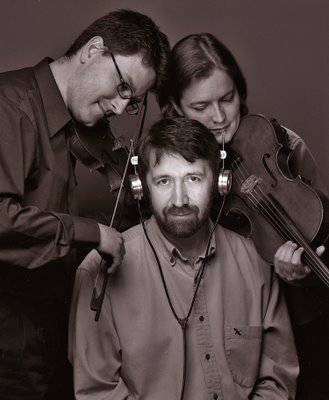
At last Friday's concert of the Turning Point Ensemble I spotted a smiling face up in the sound booth. It was that of CBC sound man extraordinaire Don Harder. There is a story that has been going around Vancouver that says that when English virtuoso baroque violinist and conductor Monica Huggett visited Vancouver for a concert she attempted to lure Harder back to Europe as a sound technician and recorder of her future concerts and recording sessions. That Don Harder is still in Vancouver, testifies to the Old World's loss and our continuing gain. Many, if not most of the recordings of classical and new music concerts that you hear on CBC Radio are Harder's work as must also be a long string of CBC CD recordings that have won prizes. When I had to photograph Don Harder in 2002 for the Straight I came up with the idea of taking his portrait with a couple of inspirational angels. I called violinist Paul Luchkow and his violist wife Glenys Webster . They were delighted and they told me many other stories of Harder's reputation in Vancouver as a sound recording engineer.
The placing of musicians at all the levels of the Telus Theatre of last Friday's concert of the music of Charles Ives (see link above) was a stupendous experience for the audience but it must have been a recording nightmare. The sound came from different places so it would surely have taxed but probably delighted Harder's efforts to record the concert. I saw the hanging mikes so he must have been recording the concert. It is my hope that this will be announced and broadcast so we can enjoy the concert all over again and perhaps it will not only be our city's musicians but also our listeners who will realize we have a national treasure in Vancouver. He is alive and well and his name is Don Harder.
This glowing exposition of Harder's talents is in no way a personal effort on my part to apologize for that one uncontrolled sneeze of mine in Friday's concert. But I do apologize knowing with certainty that Harder will eliminate it with no problem.
Of Gardens and Granddaughters
Wednesday, April 22, 2009
 For many of my 30 years in Vancouver, I was plagued by Italian cars with a slipping clutch. My mechanic, Girolamo Clemente, would say, “It could fail today, in a week, or in a year. I can’t tell you when.” So I became used to nursing a slipping clutch and identified my own life with that of my cars. The trick with both is to drive to the destination with minimum expense for maintenance and to synchronize mechanical failure with arrival. At 66, I often remark to my friends that, after half a century of existence, the rest is a bonus and I need not worry about keeping fit, running, or eating well to live longer. My granddaugthers, eleven-year-old Rebecca and six-year-old Lauren have changed all that. It all started when Rebecca was six and she asked me why I had my hand on the shift lever of our family car (which my wife has named Sophie). “Papi,” Rebecca said, “Sophie is an automatic.” I was speechless. Since then I have wanted to live as long as I can, to see what she will come up with next. Rosemary and I work on our heavy-duty corner garden in Kerrisdale for more than 10 months of the year. The work seems to get tougher every year. The thought of a smaller garden has been an attractive alternative, but we discarded that idea the moment Rebecca began to walk. She would run into the house and rush through the kitchen and out to the backyard. We have come to understand that we are going to stay with our large yard for Rebecca and her sister Lauren, as the garden will be their bank of future memories. Rebecca’s education in the garden began almost as soon as she was born, with our babysitting chores, usually on Saturdays. On nice days, we would put a blanket on the lawn and lie down to listen to “Saturday Afternoon at the Opera” on CBC Radio. By the time Rebecca was three, she was interested in smelling the roses, and by the time she was 8, she demanded we take her to Madama Butterfly. In June of 2003, we traveled with Rebecca to the American Hosta Society national convention in Washington, D.C. One day, we hopped on the Metro to go to the zoo, and Rebecca observed a fellow passenger who had an AHS convention name tag. “Do you have Hosta ‘Janet’?” Rebecca asked the woman. She replied that not only did she have Janet, she also possessed a splendid specimen of June. Rebecca came back with Marilyn, Mildred Seaver, and Mary Marie Ann, all hostas in our garden. We knew then that Rebecca had not only an uncommon interest in plants but also a very good memory. Coming home on the airplane, Rebecca clutched a plush cat given to her by the Hosta Queen herself, Mildred Seaver, which Rebecca instantly named Rosa. Packed in our luggage was a clandestine import: Rebecca’s miniature Hosta ‘Cat’s Eye’. I have learned to look at our garden through Rebecca’s eyes. I tend to buy plants with stories, so that I can tell them to her; I have played her Dvorak’s cello concerto performed by Jacqueline du Pré, so that both of us can imagine the music when we look at her lovely white namesake, Rosa ‘Jacqueline du Pré’. Rebecca’s favourite pastime is our bamboo-stick game. With stick in hand, she is ready to run to mark the location of any particular rose. I might mention a rose that smells of magnolia, soap, and lemon (‘Fair Bianca’) or ask her to spot the location and name of a red rose with a white edge ( Rosa ‘Baron Girod d’Lain’), and she knows where to find most of my 60 roses. After I showed Rebecca the scans I have made of roses by placing them directly on my flatbed scanner, it wasn’t long before she started running into the house with seeds, leaves, butterflies, bees, wasps, and even a fly that she had swatted, demanding: “Scan this one.”  There is a bittersweet paradox in all this. As Rebecca pushes me in the direction of my youth and invigorates my life, she is growing up. I have taken many pictures of her in the garden. At first she would strike poses while asking me, “How’s this?” The photos were intriguing, but when I showed them to Rosemary, she was disturbed by them. It didn’t take me long to figure out that the poses were of a child wanting to look like an adult. They remind me of the 19th-century portraits of Alice Liddell by Reverend Charles Dodgson (Lewis Carroll). I don’t worry too much. Now Rebecca objects to having her pictures taken but her sister Lauren is most keen. The wonderful experiece of educating Rebecca through the garden is now happening all over again with Lauren. Meanwhile, I can’t wait for next Saturday to tell Lauren as I once told Rebecca how my Taxus baccata ‘ Standishii’ brings to mind the long bows of English yew that defeated the French at Crécy and at Agincourt. Somehow now not only because of Rebecca but also because of Lauren I want more borrowed time.
That First Take Syndrome
Tuesday, April 21, 2009
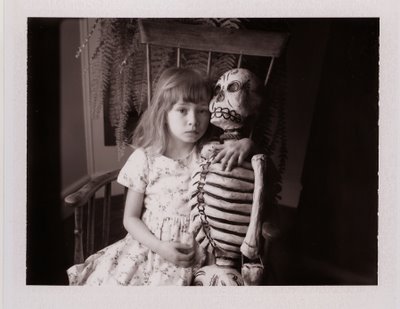 I remember watching the making of several CBC drama series, particularly on location on the Sunshine Coast. Since this was some years ago they used one camera and film. It was a surprise to see how they would focus on an actor or actors from one point of view and the actor would say all his lines. Then they would move the camera to a new position (the actor's side, as an example) and repeat it all over again. The film editor would then cut and splice the different takes into what would become the final edit. This to me was startling as my pervious observations in the CBC studios on 500 Hamilton had been for variety shows where they might have two main cameras (on heavy rolling stands), one on a boom, and a fourth would be a what was then considered a compact camera that was hand-held (it was bulky and heavy). During these drama series they would sometimes make 10 or more takes of the same scene from the same vantage point. Often the director, frustrated after many takes, would look at that first take and he would ask his assistants, “What was wrong with this first take?” After some silence he would then holler, “That’s a keeper.”  I don’t shoot video of movies. In the parlance of film making (even when the film making is digital and no film is used) I am a stills photographer. A stills photographer shoots promotional stills that are then used in publications to advertise the production. Being called a stills photographer annoys me as I like to point out to film photographers (not quite the same thing as cinematographers) that we stills photographers were shooting still pictures at least 50 years before moving pictures were regularly taken. And furthermore I would now add that Eadweard Muybridge took the first moving pictures with banks of still cameras. This would mean that the first cinematographer was a stills photographer. But there is one peculiar element that this stills photographer shares with those finicky directors who demand countless takes and then decide on that first one. I have observed this syndrome with Polaroids. I call it the First Polaroid Syndrome. What this means is that after that first good, interesting and sometimes remarkable first Polaroid, secondary Polaroids and the use of “real” film in a “real film” stills camera will not produce anything that matches that first picture. 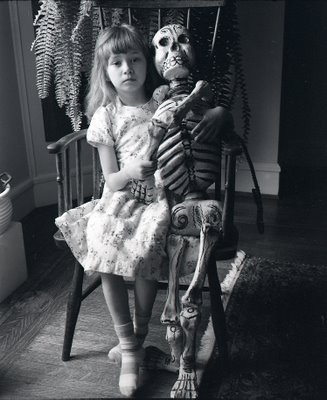 Now that Polaroids are bankrupt history I use an instant film made my Fuji. I have determined that this film is far better than the Polaroid but that it lacks a bit of the nice granularity of Polaroid so that scans lack a bit of texture and the Fuji instant film scans more like a well printed classic b+w darkroom print. But you can judge here that First Fujiroid Syndrome.  The opening picture of Lauren is the Fuji one. The subsequent ones in b+w are taken with my very last Agfa ISO 400, 120 roll film. And the colour one is Ektachrome 100G. Both the Fuji and the Agfa pictures are with available window light. For the Ektachrome I used a softbox on the left. I think the Fuji first take has a charm that is a bit lost in my other efforts. When I mentioned to Lauren that I liked how she crossed her legs she told me, "Papi its just like "Pancho el esqueleto". Pancho is a Mexican papier-mâché squeleton given to me last summer by Abraham Rogatnick. Rogatnick who is about to celebrate his 86th birthday is trying to get his life in order so he can die in peace. This means that he is getting rid of stuff. Pancho sits on a chair, with his leggs crossed, in our living room.
Not Bored With Village Of The Damned
Monday, April 20, 2009
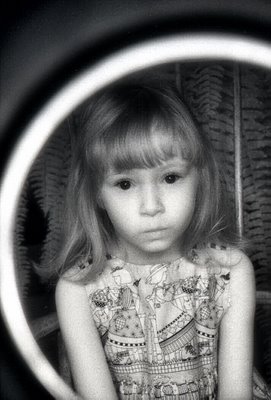
In the late 50s and early 60s I went on a science fiction novel binge and I read everything I could find including (not my favourites) short stories. I read Heinlein, Asimov, Sturgeon, Clarke, Farmer, Kornbluth, and both Gore Vidal ( Messiah) and Kurt Vonnegut ( The Sirens of Titan) who were then known as science fiction writers. I also read John Wyndam’s The Day of the Triffids and The Midwich Cuckoos. The later was filmed in 1960 as Village of the Damned. The Midwich Cuckoos and Theodore Sturgeon's More Than Human were particularly to my liking because the topic was about human evolution evolving from changes in the body to that of changes in the mind. In both novels humans became social "hyper-animals" much like bees and what one knew the rest instantly knew. I am charmed now to find out that particle physicists assert that two electrons on either side of our universe can somehow converse instantly.
Around 1964 I met the director of the film Wolf Rilla who lectured us on his film at the Israeli-Mexican Cultural Institute. He told us how the trick of the strange eyes was performed. Still photos were taken and the eyes were bleached out. When the children were doing there thing in the movie the camera would go from a wide shot and end up in the modified still. This, of course was how directors managed in the age before special effects.
This film left a profound impression in me. It was one of the few films were the great English actor George Sanders played, not a villain, but a sympathetic and understanding good man. This was far from his hateful role as the children’s author Miles Fairley in one of my favourite films of all time the 1947 The Ghost and Mrs. Muir with Gene Tierney and Rex Harrison and directed by Joseph Mankiewicz. Village of the Damned managed to be scary with little gore and no special effects. It was a subtle film done well.
In 1978 I had photographed my daughters Hilary and Ale with b+w infrared film. When I noticed Hilary’s blonde bangs I immediately remembered the film. I enlarged the negative and a couple more and called the trio of pictures The Midwich Cuckoos.
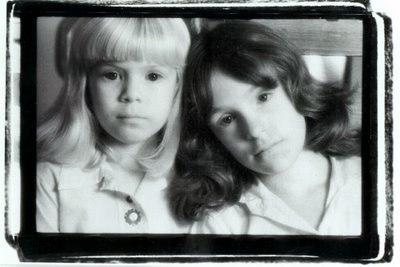
In my campaign to educate my two granddaughters, Rebecca and Lauren I like to show them films that, in the opinion of their aging grandfather, have relevant and intelligent content. Last week we sat down to see Village of the Damned. As soon as it began and Rebecca noticed that it was in b+w she said, “How can this be a scary film if we cannot see the blood?” I said nothing and soon both of them were silently watching the film with lots of interest. After the film they both went to our guest bathroom to look at the pictures of their mother and aunt on the wall. When they returned I noticed Lauren’s blonde bangs and…
On Saturday I photographed Lauren with Kodak Infrared film. Perhaps the look is different this time around as I used a ring-flash instead of my normal soft box. But Lauren still looks scary and so does her sister in the accompanying snapshot. Lauren was most cooperative and delighted but she did say, “You are going to put a picture of me on the wall, aren’t you?” It seems I will have to. I took some normal shots with colour film and some of them are delightful. One of them will be up on the walls soon.

At the end of our viewing of the film I told Rebecca that George Sanders had committed suicide and left a note that said, “I was bored.” She became quite serious and Rosemary winced at my telling her the story. According to the records:
He had at one time 7 psychiatrists, but they were of little help because in 1972 he took seven tubes of Nembutal in Barcelona, Spain and ended his life. His suicide note read:
"Dear World: I am leaving because I am bored. I am leaving you with your worries in this sweet cesspool."
But there is another version that is a tad kinder and more positive:
“Dear World, I am leaving you because I am bored. I am leaving you with your worries. Good luck."

Shostakovich, Stalingrad, Kharkov & Kursk
Sunday, April 19, 2009

Around 1972 my friend Jorge Urrechega sold me (cheap) a new transistor (one of the first in those days) Acoustic Research amplifier with an accompanying and lovely Acoustic Research turntable. The turntable was a beauty of design and the amplifier had knobs that were the absolute necessary ones (5) all made of solid brass. I immediately bought an expensive Shure cartridge. I was almost all set for listening to good music as it should be listened to. Except I had no decent speakers and no way of getting any in Mexico City where there was an import ban on anything manufactured in the US. Jorge would come and we would play Vivaldi’s Gloria and Richard Strauss’ Also sprach Zarathustra, Op. 30. When the latter began with its fanfare that ended with a very low pedal bass sound from the organ Jorge would wince and almost cry. “You need some good speakers,"he told me. “I suggest you get the best that you can afford and these would be the Acoustic Research AR-3As."
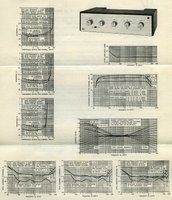
I had befriended one of my neighbors who lived at the end of our block in our Mexico City suburb of Arboledas. Alfarache was a blond/redhaired engineer who worked for the government petroleum company Pemex. I played volleyball on the street with my other neighbours but Alfarache disdained all sports. He was much keener about the weekend domino sessions. He was very good. But what separated him from most of my neighbours and made him somewhat of a loner was his penchant for listening to classical music, very loud in the comfort of his home. He looked down upon popular Mexican music and abhorred American pop. I guess he was a well-read snob. I liked his kind of music.

I told Alfarache of my problem. With a smile on his face he told me, “We are going to order a couple of hydraulic pumps from Houston and bring them into my office. I will deliver them to you in a couple of weeks. Now give me some money to buy them.”
Two weeks later Alfarache arrived at my door and we unpacked the most beautiful speakers (AR-3As) I had ever seen. We connected everything and I was just about to test my Strauss when Alfarache interrupted me, “Permit me Alex. Let’s listen to this first. And let’s play it real loud.” It was Dmitri Shostakovich’s Symphony No.5, Op. 47 with Kirill Kondrashin directing the Leningrad Orchestra.
I cannot stress here how this symphony changed my outlook towards Russian music. I had always only just tolerated the overly romantic Tchaikovsky. Alfarache mentioned that the second movement had a piano part where the piano sounded like the real percussion instrument it was supposed to be. That was the case. I remember it was a hot day but as the music played I was transported to a Russian winter. To this day this symphony is my favourite symphony.
Last night I went to see a live performance (my first) of Symphony No.5 at Shaughnessy Heights United Church. The orchestra playing it was the Vancouver Philharmonic Orchestra directed by Jin Zhang.

I went with some apprehension that I would find the performance lacking. I should not have been concerned. The performance was all that I imagined it to be. The piano part was as it had to be and the rest of the orchestra fluctuated between a bitter sweetness to loud triumphant parts. It was in the fourth and last movement, Allegro non troppo that I saw five percussionists all smile as they smashed their instruments with no apparent restraint. From the vantage of my seat on the fourth row it was really loud, it was gloriously loud. I am sure that Alfarache would have smiled and told me, “This is how music must be heard.”
But something else happened during last night’s performance. That first movement is an extreme cold and sobering experience. It is of despair. For me it is about the siege of Stalingrad even though I know Shostakovich wrote this work in 1937. I know that the subtitle of the work (he was attempting to rehabilitate himself with the Russian authorities and perhaps avoid being sent to Stalin’s gulag who had hated his last work, the opera Lady Macbeth of Mtsensk) A Soviet Artist’s Practical Creative Reply to Just Criticism. As the music progressed I saw tanks and imagined their rumbling and the roar of their guns. I saw plains of snow and Russian and German soldiers in long winter coats. I could almost hear the sound of the tank's metal tracks.
The German army was soundly defeated by the Russians at Stalingrad between November 1942 and January 1943. Then at the Third Battle of Kharkov, between February 20 and March 18, 1943 the Germans under the command of General Erich von Manstein almost compensated for their prior loss. And then between July and August 1943 the Russians defeated the Germans in one of the biggest tank battles of all time at Kursk. Tanks figured in two of these battles. In the end the Russian tanks were victors over the German tanks. While some of the German tanks may have been better machines they could not compensate for the many more tanks that the Russians had at their disposal.
When I heard the kettle drums in the last movement I heard the victorious Russian tanks in pursuit of the Germans who lost 1000 tanks and 100,000 men.

When I arrived home I went to my Yugoslavia file. I remembered I had photographed some tanks in a park by the Danube in Belgrade. I am sure amongst these there must be some of those Russian tanks.
Addendum courtesy of Ian McGuffie
First Photograph: German Stug III assault gun. That is a fixed "turret" that does not turn. To aim gun, tread turning was used.
Second Photograph: German Mark II Panzer and behind American M III Stewart
Third Photograph: Front view of M III Stewart
Fourth Photograph: German Mark IV Panzer. Ian McGuffie further comments that the Russians used American tanks (which they hated) in a Lend-Lease agreement with the US. He cannot understand why there are no Russian tanks in the Belgrade collection.
|































